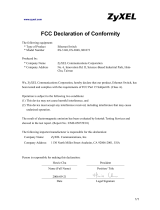
Chapter 3 Web Configurator
PLA6456 User’s Guide
19
3.4 IP Settings
Use the IP screen to enable DHCP, or manually assign an IPv4 or IPv6 address, subnet mask, default
gateway, and DNS server to the PLA.
Force node Type This field forces the PLA to have a particular role (END_POINT or DOMAIN_MASTER).
• Select DOMAIN_MASTER if your PLA connects to a router/AP.
• Select END_POINT if your PLA connects to the end device (for example, computer).
• It is recommended to select the default setting AUTOMATIC for automatic role detection of
the PLA.
Node type Shows the current role of the device based on your selection in the previous field.
Note: Node type change can take some time, click Ok after making any changes in
the Force node Type field. You may need to refresh your webpage.
G.hn profile This field selects the G.hn profile of all PLAs to apply in the HomeGrid network (PLC 100 MHz
MIMO Boost, PLC 100 MHz Boost).
• Select PLC 100 MHz MIMO Boost (multiple input multiple output) when the PLA connects to a
3-prong electrical socket in your home. Multiple electrical paths between PLAs in the same
HomeGrid network are available and sending and receiving of data is through all 3 wires
(power, neutral, and ground).
• Select PLC 100 MHz Boost when the PLA connects to a 2-wire electrical socket. A single
electrical path between PLAs in the same HomeGrid network is available and sending and
receiving of data is through the 2 wires (power and neutral).
Encryption Configuration
Encryption is DISABLED
Pairing password Use this password for authentication. Enter a custom password to manually create a secure
connection with another PLA. The password can be up to 30 alphanumeric and special
characters. Then click Change.
Automatic
configuration
Before connecting, make sure the other PLA is using the same Pairing password. Then click Pair
to allow connection with another PLA in the same power circuit. Wait a few minutes for the
connection, you may need to refresh your webpage to update the status.
Available
Connections
This field list all the available G.hn connection details (remote node Device ID, MAC address,
Phy Tx (Mbps) transmission and Phy Rx (Mbps) reception physical speeds. Phy Tx (Mbps) refers to
how fast information is sent from the selected PLA to this PLA. Phy Rx (Mbps) refers to how fast
information is received from the selected PLA to this PLA.
Table 5 G.hn Screen (continued)
LABEL DESCRIPTION





















